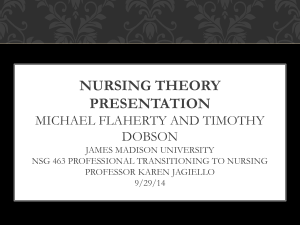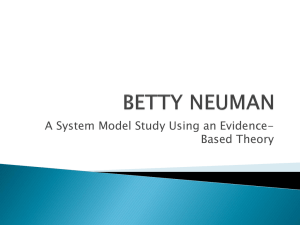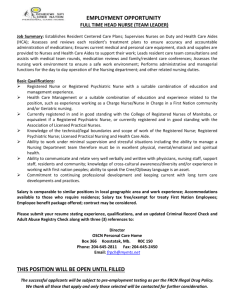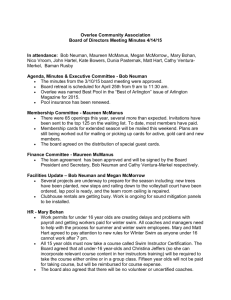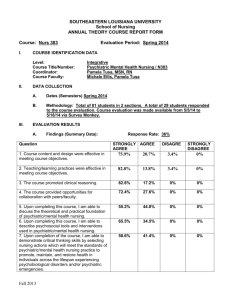Exploring Nursing Theories
advertisement
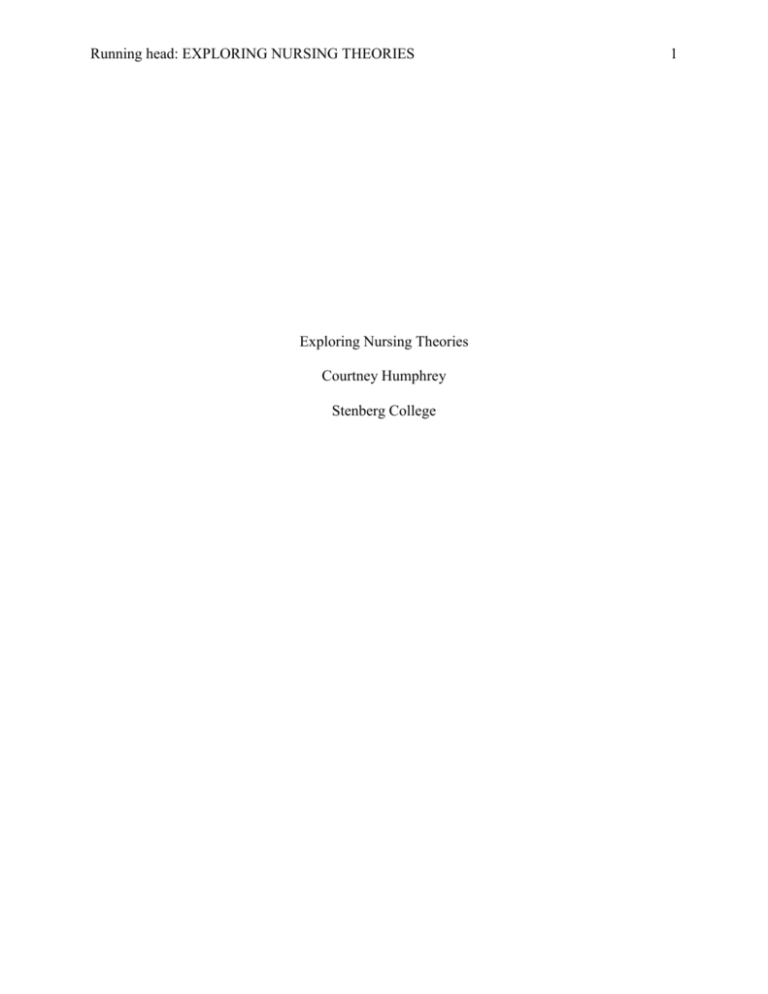
Running head: EXPLORING NURSING THEORIES Exploring Nursing Theories Courtney Humphrey Stenberg College 1 EXPLORING NURSING THEORIES 2 Exploring Nursing Theories The implementation of theoretical approaches bridges the gap between psychiatric nursing theory and practice. When psychiatric nurses explore these theoretical ideas they become consciously aware of their values and beliefs and thus begin to practice more safely and effectively. Theoretical models act as guidelines for psychiatric nurses to follow when they administer care to others. Similarly, it facilitates the opportunity for nurses to view themselves from a different angle, one that they may have over-looked beforehand. In turn, this supports the strength of the nurse’s practice and therefore provides consistency throughout it. Psychiatric nurses must take it upon themselves to figure out what theories work best for their practice. However, this is not to say that their decision of what model to use has to be definitive. Psychiatric nurses must recognize that theories, like themselves are continuously changing and developing. As nurses grow and become more experienced in their craft their theories must mold with them. On the other hand, if these theories no longer match the psychiatric nurse’s values and beliefs they must seek out new theories that do. Traditionally, psychiatric nurses have relied solely on the biomedical model approach which focuses on the scientific methods of treatment. Conversely, they do not take into account the variety of differences found amongst individuals. However, when we focus on a theoretical approach to health care we can implement better patient care. It is imperative then that different types of models are discussed so that it opens up dialogue between psychiatric nurses. As we explore the Neuman Systems Model – developed by Dr. Betty Neuman – we begin to understand the model in terms of how it can be used, where psychiatric nurses can use it, and what validity, if any, does it hold. EXPLORING NURSING THEORIES 3 The Neuman System Model is used as a conceptual framework to guide psychiatric nursing care. It provides a holistic approach to health care while also being both flexible and practical in its use. It is a universal and open-based perspective that allows psychiatric nurses to focus in on an array of health concerns. It is believed that the Neuman Systems Model “has the necessary characteristics to guide nursing care with particular focus” (Moore & Munro, 1990, p. 293). More specifically, the Neuman Systems Model’s main emphasis is directed on the patient’s response to environmental stressors. When a patient is exposed to stress their normal line of defense is triggered in an attempt to maintain homeostasis. However, if the patient is unable to deal with these stressors their internal structure may crumble. If the patient’s internal balance is compromised, this then gives illness the opportunity to develop. What factors could possibly affect a patient’s homeostasis? There are certainly many factors both internally and externally that can contribute to the disturbance of a patient’s over-all health. However, psychiatric nurse can use the Neuman Systems Model as a tool to help identify these stressors. Psychiatric nurses have a responsibility to reduce illness while maintaining patient’s optimal level of health. It is imperative then that psychiatric nurses implement the Neuman Systems Model so that they can carry out this obligation. The Neuman Systems Model is also used to assist psychiatric nurses in the intervention process for patient care. The Neuman Systems Model uses a primary, secondary and tertiary system to deal with patient care. The primary level of prevention is used by psychiatric nurses to help them recognize “positive ways to cope with changes and potential crises” (Moore & Munro, 1990, p. 297). The secondary level of prevention identifies patient symptoms and offers interventions that are related to their symptoms. The tertiary level focuses on re-education to prevent future occurrences and maintain patient’s stability. For example, if a patient is unable to handle a stressor it may cause an internal EXPLORING NURSING THEORIES 4 breakdown in their bodies’ first line of defense. Therefore, the patient’s body system would begin to become extremely unbalanced. It is imperative that, to deal with this situation properly, the psychiatric nurse must go through each of the three systems. Firstly, with the primary prevention process, the psychiatric nurse may focus on incorporating relaxation techniques into their patients care plan. In turn, this would begin to decrease the patient’s over-all stress levels while restoring their internal balance. Secondly, the psychiatric nurse may use medication to treat any symptoms that have been caused by the patient’s illness. During the secondary prevention system the patient is also given the opportunity to voice any concerns they may have. Lastly, after re-education the psychiatric nurse would re-assess the patients for signs that homeostasis had been restored. It is important that the patient continues to maintain their support system to avoid recurrence. It is clear that the Neuman Systems Model can act as an imperative tool to guide the maintenance and restoration of patient’s health. The Neuman Systems Model is used by psychiatric nurses in various health care settings. Due to the model’s flexibility it can be found in community practice, educational institutions and at numerous clinical capacities. The Neuman Systems Model can be used not only by psychiatric nurses but by other members found on the medical team. Moreover, this is why the Neuman Systems Model is found not only in practice, but in teaching in a multitude of places. The Neuman Systems Model focuses on a patient as a whole which is why it is applicable across heath care disciplines. The model has the potential for addressing the needs of these disciplines, which would explain why it is so widely used (Moore & Munro, 1990, p. 298). The model can also be used to tackle the nursing process when it comes to dealing with patient care. It is used in the patient’s assessment process and can assist psychiatric nurses in making a diagnosis. Psychiatric nurses may also use the Neuman Systems Model to identify stressors that affect EXPLORING NURSING THEORIES 5 patients. From here, psychiatric nurses can begin to implement care plans for their patient. Although the Neuman Systems Model is used in numerous health care settings it can also be used by nursing students. A correlational study was conducted by Eula et al. (2012) that showed how the Neuman Systems Model can be used amongst nursing students to reduce their stress. The study looked at 166 baccalaureate nursing students who used the model to empower themselves which subsequently helped reduce their stress levels. Authors Eula et al. (2012) in Stress resiliency, psychological empowerment and conflict management styles among baccalaureate nursing students concluded that the Neuman Systems Model can be used by educators as a guide to strengthen nursing student’s management of stressors in the workplace (Pines et al., 2012, p. 1482). Clearly, this proves the versatility of the Neuman Systems Model and shows how it can be used in various settings. Over the years, much research has been conducted which proves the validity of the Neuman Systems Model. It was said to have “proven its validity as a wholistic global perspective for interdisciplinary health care concerns” (Neuman, 2011, para. 1). The fact that the model is used throughout many medical institutions proves its importance and usefulness in the medical community. How can the Neuman Systems Model prove its validity? By implementing the model into medical research we can therefore test and measure what the researchers intends to prove and see how the model facilitates this process. In 2003 the Neuman Systems Model Research Institute (NSMRI) was created specifically to test the Neuman Systems Model theory (Skalski, DiGerolamo, & Gigliott, 2006, p. 70). The NSMRI identified key concepts and existing research based on the Neuman Systems Model. Much of the NSMRS focus was on patient’s response to environmental stressors. Out of all the studies conducted, ‘stressors’ was the conceptual category most frequently studied within the Neuman Systems Model. On the other EXPLORING NURSING THEORIES 6 hand, research has also focused on how the Neuman Systems Model can be applied to practice which further proves its validity in the workforce. It is the responsibility of psychiatric nurses to “maintain, regain or attain [a patient’s] stability” (Knight, 1990, p. 450), and the implementation of the Neuman Systems Theory assists the nurse in carrying out this duty. Furthermore, the flexibility of the model allows its use in dealing with various types of patients. What this also does is permit psychiatric nurses to prove – in different ways – the validity of the model. For example, author Janet Knight in The Betty Neuman Systems Model applied to practice: a client with multiple sclerosis (1990) investigated the validity of the Neuman Systems Model when applied to the patient care of those suffering with multiple sclerosis (MS). The model was applied to a case study of a young women suffering from the disease. The author felt that the “Betty Neuman Systems Model [was] ideally suited for guided nursing practice” (Knight, 1990, p. 448). More specifically, the model – because of its versatility – was a perfect fit in relations to patients suffering from MS. The author goes on to suggest that the Neuman Systems Theory is “extremely helpful in dealing with various clients’ feelings, attitudes, and belief that may affect the course of [their] disease” (Knight, 1990, p. 448). Furthermore, it was felt that the model is an extremely useful framework used to prevent, treat and rehabilitate the patient. Therefore the Neuman Systems Model should be implemented into the psychiatric nurse’s practice to further assist in patient care. The author noted that when the Neuman System Theory was implemented it allowed nurses to understand the various stressors that were affecting the patient and they were able to formulate interventions. Interventions were made following the primary, secondary and tertiary levels of prevention. It was concluded by the author that the Neuman System model “demonstrated to be useful and effective in the implantation of the nursing process” (Knight, EXPLORING NURSING THEORIES 1990, p. 447). Likewise, it is apparent that the Neuman Systems Theory is a vital tool in patient care and its validity is continually proven in the application of it. Nursing theories are used by psychiatric nurses as a framework to deliver quality patient care. Without the application of nursing theories it would be difficult for psychiatric nurses to focus their care to mirror their values and beliefs. The Neuman Systems Model provides a holistic approach to patient intervention. It is used in an array of various health care setting and has proven to hold its validity in the psychiatric nursing practice. 7 EXPLORING NURSING THEORIES 8 References Knight, J. (1990). The Betty Neuman Systems Model applied to practice: a client with multiple sclerosis. Journal Of Advanced Nursing, 15(4), 447-455. http://dx.doi.org/doi:10.1111/1365-2648.ep8530016 Moore, S., & Munro, M. (1990). The Neuman System Model applied to mental health nursing of older adults. Journal Of Advanced Nursing , 15(3), 293-299. http://dx.doi.org/doi:10.1111/j.1365-2648.1990.tb01816.x Neuman, B. (2011). Neuman systems model. Retrieved from http://www.neumansystemsmodel.org/ Pines, E., Rauschhuber, M., Jones, M., Norgan, G., Cook, J., Canchola, L., & Richardson, C. (2012). Stress resiliency, psychological empowerment and conflict management styles among baccalaureate nursing students. Journal Of Advanced Nursing, 68(7), 1482-1493. http://dx.doi.org/doi:10.1111/j.1365-2648.2011.05875.x Skalski, C., DiGerolamo, L., & Gigliott, E. (2006). Stressors in five client populations: Neuman systems model-based literature review. Journal Of Advanced Nursing, 56(1), 69-78. http://dx.doi.org/doi:10.1111/j.1365-2648.2006.03981.x
